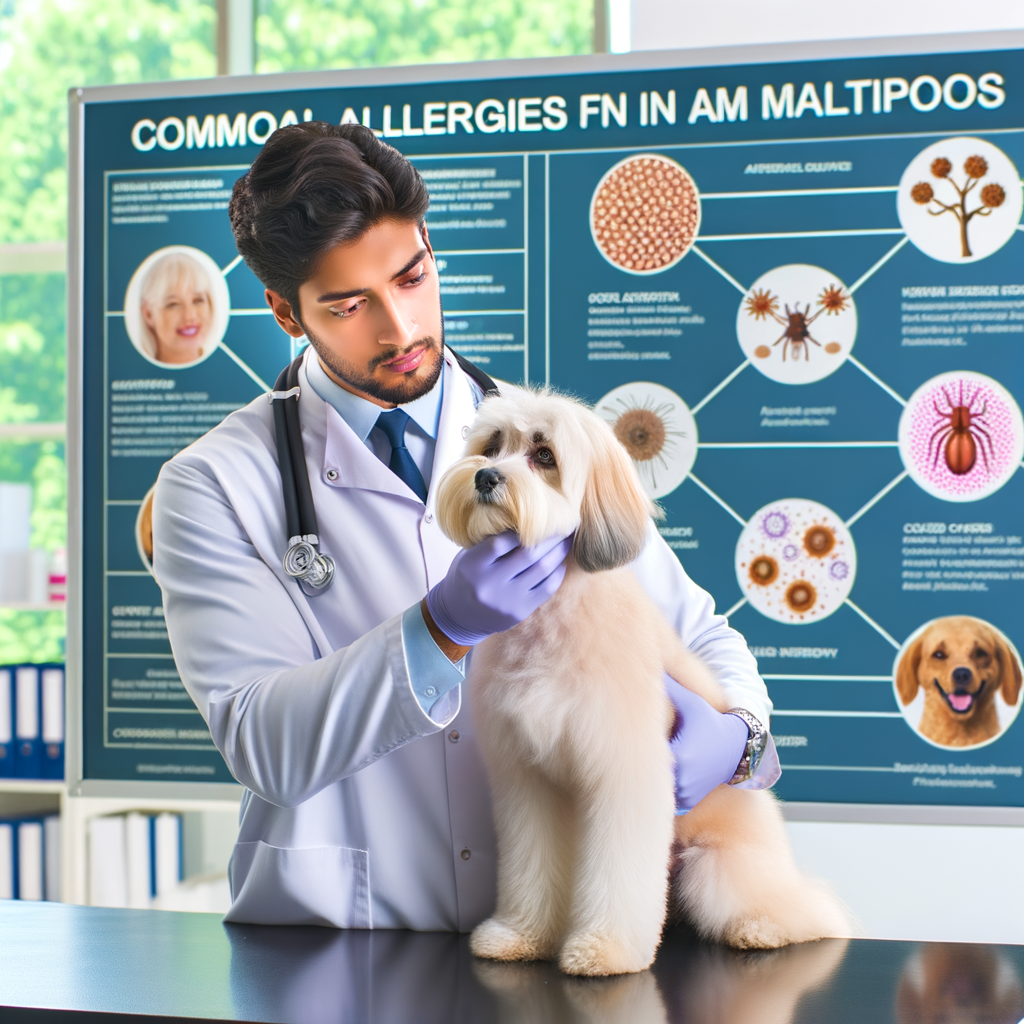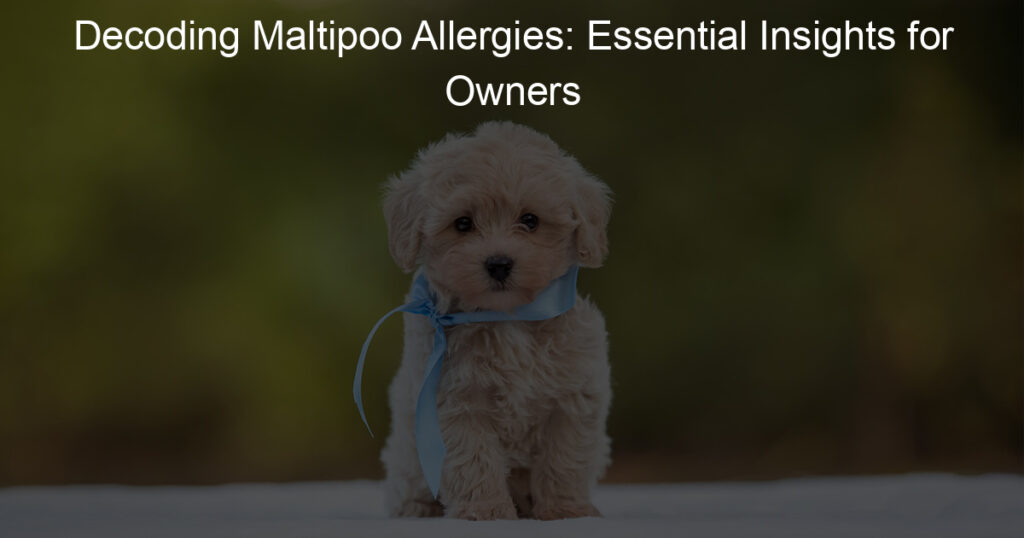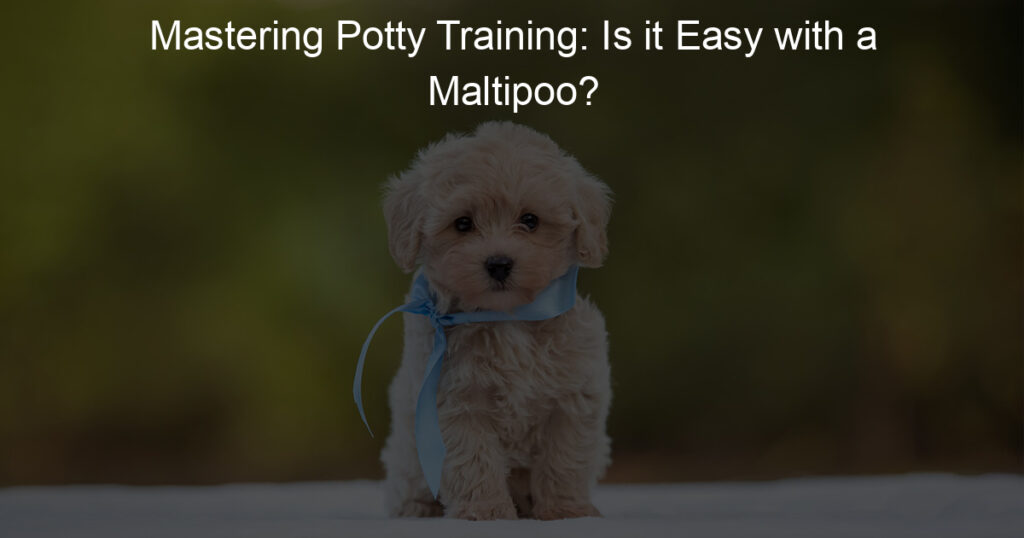
Understanding Maltipoo Allergies
Just like humans, our furry friends can also suffer from allergies. Maltipoos, a popular breed known for their fluffy coats and friendly nature, are no exception. In this section, we will delve into the world of Maltipoo allergies, their common causes, and how they differ from allergies in other breeds.
- Defining Maltipoo Allergies
- Common Causes of Allergies in Maltipoos
- How Maltipoo Breed Allergies Differ from Other Breeds
Allergies in Maltipoos occur when their immune system reacts to substances in their environment that are typically harmless to most dogs. These substances, known as allergens, can be found in food, the air, or even on their skin. When a Maltipoo is allergic to a particular allergen, their body will produce symptoms such as itching, sneezing, or digestive issues.
Maltipoos can be allergic to a variety of things. Some common allergens include certain types of food, dust mites, pollen, mold, and fleas. For example, a study showed that 10% of Maltipoos have food allergies, with chicken, beef, and dairy being the most common culprits. Environmental allergens like dust mites and pollen can also cause allergies in Maltipoos, especially during certain seasons.
Every dog breed has a unique genetic makeup, and this can influence their susceptibility to certain allergies. Maltipoos, being a mix of Maltese and Poodle, inherit traits from both parent breeds. This means they may be more prone to certain allergies compared to other breeds. For instance, Maltipoos are often more susceptible to skin allergies due to their curly and dense coat, which can trap allergens more easily than the short coat of a breed like the Beagle.
In the following sections, we will discuss how to identify Maltipoo allergy symptoms, treatments available, and how to prevent allergies in your Maltipoo. Stay tuned to learn more about managing Maltipoo allergies effectively.
Identifying Maltipoo Allergy Symptoms
Recognizing the symptoms of allergies in your Maltipoo is the first step towards ensuring their health and happiness. Allergies can manifest in various ways, and it’s crucial to be aware of the signs. Let’s explore the physical signs, behavioral changes, and when it’s time to consult a vet.
- Physical signs of Maltipoo allergies
- Excessive scratching, biting, or licking of the skin
- Red, inflamed skin
- Hair loss
- Runny nose or eyes
- Frequent sneezing or coughing
- Vomiting or diarrhea
- Behavioral changes due to allergies
- Increased restlessness or agitation
- Loss of appetite
- Decreased activity or lethargy
- Excessive grooming or cleaning
- When to consult a vet
Physical symptoms are the most noticeable signs of allergies in Maltipoos. These may include:
If you notice any of these symptoms, it’s possible your Maltipoo is suffering from allergies. However, it’s essential to consult a vet for a proper diagnosis.
Behavioral changes can also indicate that your Maltipoo is dealing with allergies. These changes can be subtle, so it’s important to pay close attention to your pet’s behavior. Some common behavioral symptoms of allergies include:
These changes can be a sign of discomfort or distress caused by allergies. If you notice any of these behaviors, it’s advisable to consult a vet.
If your Maltipoo is showing any of the above physical or behavioral symptoms, it’s time to consult a vet. Even if the symptoms seem mild, it’s better to be safe than sorry. Allergies can worsen over time if left untreated, leading to more serious health issues. Therefore, it’s crucial to seek professional help as soon as you notice any signs of allergies in your Maltipoo.
In conclusion, being aware of the signs of allergies in your Maltipoo is crucial for their wellbeing. By recognizing the physical and behavioral symptoms early, you can seek professional help and ensure your pet gets the treatment they need.
Maltipoo Allergy Treatment
When your Maltipoo shows signs of allergies, it’s essential to seek professional help. A vet can provide various medical treatments to help manage your pet’s symptoms and improve their quality of life. Let’s explore some of these treatments.
Medical Treatments
Medical treatments for Maltipoo allergies can be categorized into three main types: prescription medications, allergy shots, and topical treatments. Each of these has its own benefits and is used based on the severity and type of allergy your Maltipoo is experiencing.
- Prescription Medications: These are drugs that your vet may prescribe to help control your Maltipoo’s allergic reactions. They can include antihistamines, corticosteroids, or other anti-inflammatory drugs. These medications can help reduce itching, swelling, and other symptoms associated with allergies. Remember, these medications should only be used under the supervision of a vet.
- Allergy Shots: Also known as immunotherapy, allergy shots are used to help your pet’s immune system become less sensitive to the allergen causing the reaction. This treatment involves giving your Maltipoo small doses of the allergen over time, which can help reduce the severity of allergic reactions in the future. It’s a long-term solution that requires patience and commitment.
- Topical Treatments: These are creams, ointments, or sprays applied directly to your Maltipoo’s skin to help relieve symptoms like itching and inflammation. Topical treatments can be particularly useful for localized allergies, such as those caused by contact with certain plants or substances. Always follow your vet’s instructions when using these treatments to ensure they’re effective and safe.
It’s crucial to remember that every Maltipoo is unique, and what works for one may not work for another. Therefore, it’s essential to work closely with your vet to find the most effective treatment plan for your furry friend.
Home Remedies
While medical treatments are often necessary for Maltipoo allergies, there are also several home remedies that can help manage your furry friend’s symptoms. These remedies include natural supplements, dietary changes, and environmental modifications. Let’s explore each of these in more detail.
- Natural Supplements
- Dietary Changes
- Environmental Modifications
Natural supplements can be a great addition to your Maltipoo’s diet to help combat allergies. For instance, Omega-3 fatty acids found in fish oil can help reduce inflammation and improve skin health. Probiotics, which are beneficial bacteria, can also support your dog’s immune system and gut health. Remember, it’s always best to consult with your vet before starting any new supplement regimen.
What your Maltipoo eats can have a significant impact on their allergy symptoms. Some dogs may be allergic to certain types of food, such as beef, dairy, or wheat. If you suspect a food allergy, consider switching to a hypoallergenic diet or a diet with novel proteins and carbohydrates. Always ensure that any dietary changes are gradual to avoid upsetting your dog’s stomach.
Lastly, making changes to your Maltipoo’s environment can help reduce exposure to allergens. This can include regular cleaning of your home to remove dust and dander, using hypoallergenic bedding, and limiting outdoor time during high pollen seasons. It’s also important to keep your Maltipoo’s skin clean and moisturized to prevent dryness and itching.
In conclusion, home remedies can be a valuable part of your Maltipoo’s allergy treatment plan. By combining these strategies with medical treatments, you can help your Maltipoo live a comfortable and happy life, free from the discomfort of allergies.
Allergy Prevention in Maltipoos
Preventing allergies in your Maltipoo is an essential part of their overall health and well-being. Here are some effective strategies to help reduce the risk of allergies in your furry friend.
- Regular grooming
- Proper diet
- Reducing exposure to allergens
Grooming your Maltipoo regularly is not only about keeping them looking their best, but it’s also about their health. Regular baths can help remove allergens from their fur and skin, reducing the chance of an allergic reaction. Brushing your Maltipoo’s fur daily can also help remove any allergens that may be stuck in their coat. Remember to use hypoallergenic grooming products to avoid causing any skin irritation.
Feeding your Maltipoo a balanced and nutritious diet is crucial in preventing allergies. Some Maltipoos may be allergic to certain types of food, so it’s important to monitor what they eat. If you notice any signs of an allergic reaction after they eat, such as itching or redness, it may be a sign that they are allergic to something in their diet. Consult with your vet to help identify any potential food allergens and to create a diet plan that suits your Maltipoo’s nutritional needs.
Reducing your Maltipoo’s exposure to potential allergens can greatly help in preventing allergies. This could mean keeping your Maltipoo indoors during high pollen count days or using air purifiers to reduce the amount of dust and other allergens in your home. It’s also important to keep your Maltipoo’s living area clean, including their bed and toys, to prevent the buildup of allergens.
By following these steps, you can help ensure that your Maltipoo lives a happy, healthy, and allergy-free life. Remember, every Maltipoo is unique, and what works for one may not work for another. Always consult with your vet for personalized advice on preventing allergies in your Maltipoo.
Common Allergies in Maltipoos
Maltipoos, a popular hybrid breed of the Maltese and Poodle, are known for their adorable looks and friendly nature. However, like any other breed, Maltipoos are prone to certain allergies. One of the most common types of allergies in Maltipoos is food allergies.
Food Allergies
Food allergies in Maltipoos can cause a variety of symptoms, including itching, skin rashes, and digestive issues. It’s important to be aware of the common food allergens for Maltipoos and know how to identify signs of food allergies.
- Common food allergens for Maltipoos
- How to identify food allergies
Some foods are more likely to cause allergies in Maltipoos than others. Common food allergens include wheat, dairy, soy, and certain types of protein like beef and chicken. Some Maltipoos may also be allergic to corn and artificial additives in pet food.
Identifying food allergies in Maltipoos can be tricky as symptoms can vary and may be similar to other health issues. However, common signs of food allergies include excessive scratching, skin rashes, vomiting, diarrhea, and ear infections. If you notice any of these symptoms, it’s important to consult with a vet. They may recommend an elimination diet to identify the specific allergen.
Understanding the common food allergens for Maltipoos and knowing how to identify food allergies can help keep your furry friend healthy and happy. Remember, each Maltipoo is unique and may react differently to different foods. Always consult with a vet if you suspect your Maltipoo has a food allergy.
Environmental Allergies
Just like humans, Maltipoos can also suffer from environmental allergies. These allergies occur when your pet’s immune system reacts to substances in the environment that are usually harmless. Let’s explore the common environmental allergens for Maltipoos and how to reduce their exposure to these allergens.
- Common environmental allergens for Maltipoos
- Pollen from trees, grass, and flowers
- Dust mites and household dust
- Mold spores
- Animal dander from other pets
- Feathers
- How to reduce exposure to environmental allergens
- Regularly clean your home to reduce dust and mold
- Keep your Maltipoo indoors during high pollen seasons
- Use air purifiers to reduce airborne allergens
- Regularly groom your Maltipoo to remove allergens from their fur
Maltipoos, with their fluffy coats, can be sensitive to a variety of environmental allergens. These can include:
These allergens can cause a range of symptoms in your Maltipoo, such as itching, sneezing, and watery eyes. It’s important to remember that every Maltipoo is unique, and what causes an allergic reaction in one may not affect another.
While it’s impossible to completely eliminate all environmental allergens, there are steps you can take to reduce your Maltipoo’s exposure:
By taking these steps, you can help your Maltipoo live a happier, healthier life, free from the discomfort of environmental allergies.
Maltipoo Allergy Care
When it comes to managing allergies in your Maltipoo, there are several key steps you can take. These steps are not only beneficial in treating existing allergies but also play a crucial role in preventing future allergic reactions. Let’s delve into these important aspects of Maltipoo allergy care.
- Regular check-ups with the vet
- Maintaining a clean living environment
- Proper grooming and skin care
Regular veterinary check-ups are essential for keeping your Maltipoo’s allergies under control. Your vet can monitor your pet’s health, identify any new allergies, and adjust treatment plans as necessary. Remember, early detection of allergies can make a significant difference in your pet’s comfort and health. Aim for at least two vet visits per year, or more if your Maltipoo has severe allergies.
A clean living environment can significantly reduce allergen exposure for your Maltipoo. Regularly clean your pet’s bedding, toys, and feeding bowls. Vacuum your home frequently to remove allergens like dust mites and pollen. If possible, use an air purifier to further reduce airborne allergens. Remember, a clean home is a healthier home for your Maltipoo.
Proper grooming and skin care are vital in managing your Maltipoo’s allergies. Regular baths can help remove allergens from your pet’s fur and skin. Use hypoallergenic shampoos and conditioners specially formulated for dogs with allergies. Brush your Maltipoo’s fur daily to remove loose hairs and potential allergens. Pay special attention to their paws, as allergens can often accumulate there. If your Maltipoo has skin allergies, your vet may recommend specific skin care products or treatments.
By incorporating these steps into your routine, you can help your Maltipoo live a happier, healthier life, free from the discomfort of allergies. Remember, every Maltipoo is unique, and what works for one may not work for another. Always consult with your vet to develop a personalized allergy care plan for your pet.
Case Studies: Maltipoos and Allergies
Let’s delve into some real-life case studies that illustrate the challenges and triumphs of managing allergies in Maltipoos. These stories will provide practical insights into diagnosis, treatment, and management of different types of allergies.
-
Case study 1: Diagnosis and treatment of food allergies
Meet Bella, a 2-year-old Maltipoo who started showing signs of discomfort after meals. Her owner noticed that she was scratching excessively, had red skin, and was losing hair. Bella’s vet suspected a food allergy and recommended an elimination diet to identify the culprit. After several weeks, it was discovered that Bella was allergic to chicken, a common ingredient in many dog foods.
Once the allergen was identified, Bella’s diet was adjusted to exclude chicken. Her symptoms improved significantly, and she was back to her playful self. This case highlights the importance of a careful diagnosis and the effectiveness of dietary adjustments in managing food allergies.
-
Case study 2: Managing environmental allergies
Next, we have Max, a 3-year-old Maltipoo who developed allergies to pollen. Max’s owner noticed that he would sneeze and cough during their walks, especially in the spring and fall. Max was diagnosed with environmental allergies, and his vet recommended several strategies to manage his symptoms.
Max’s owner started wiping him down with a damp cloth after walks to remove pollen from his fur. They also invested in a high-quality air purifier for their home. With these measures, Max’s symptoms were significantly reduced, demonstrating that environmental allergies can be managed with careful attention and lifestyle adjustments.
-
Case study 3: Overcoming multiple allergies
Finally, let’s look at Daisy, a Maltipoo who had both food and environmental allergies. Daisy’s case was complex, as she showed symptoms year-round, and they worsened during certain seasons. After a series of tests, Daisy was found to be allergic to beef and dust mites.
Daisy’s owner worked closely with the vet to develop a comprehensive plan that included a special diet and regular cleaning of Daisy’s living area. Despite the challenges, Daisy’s allergies were successfully managed, showing that even multiple allergies can be overcome with a dedicated and comprehensive approach.
These case studies underscore the importance of early detection, accurate diagnosis, and consistent management in dealing with Maltipoo allergies. Remember, every Maltipoo is unique, and what works for one may not work for another. Always consult with a professional vet to develop a tailored approach for your furry friend.
Key Takeaways: Managing Maltipoo Allergies
As we conclude our discussion on Maltipoo allergies, it’s important to remember a few key points. These will not only help you understand your pet’s condition better but also ensure they live a comfortable and healthy life.
- Importance of Early Detection
- Role of Regular Vet Visits
- Value of a Holistic Approach to Allergy Care
Early detection of allergies in your Maltipoo can make a significant difference. It allows for prompt treatment, which can prevent the condition from worsening. Keep an eye out for symptoms such as excessive scratching, redness, and unusual behavior. Remember, the sooner the allergy is identified, the better the chances of managing it effectively.
Regular vet visits play a crucial role in managing your Maltipoo’s allergies. Your vet can monitor your pet’s health, identify any new allergies, and adjust treatment plans as necessary. They can also provide valuable advice on how to care for your pet at home. Make sure to schedule regular check-ups for your Maltipoo.
A holistic approach to allergy care can be highly beneficial for your Maltipoo. This involves considering all aspects of your pet’s health, including diet, exercise, and mental well-being. It may also include natural remedies and lifestyle changes. A holistic approach can help manage symptoms and improve your pet’s overall health.
In conclusion, managing Maltipoo allergies requires awareness, regular vet visits, and a comprehensive approach to care. With these key takeaways in mind, you can ensure your Maltipoo leads a happy and healthy life, free from the discomfort of allergies.








